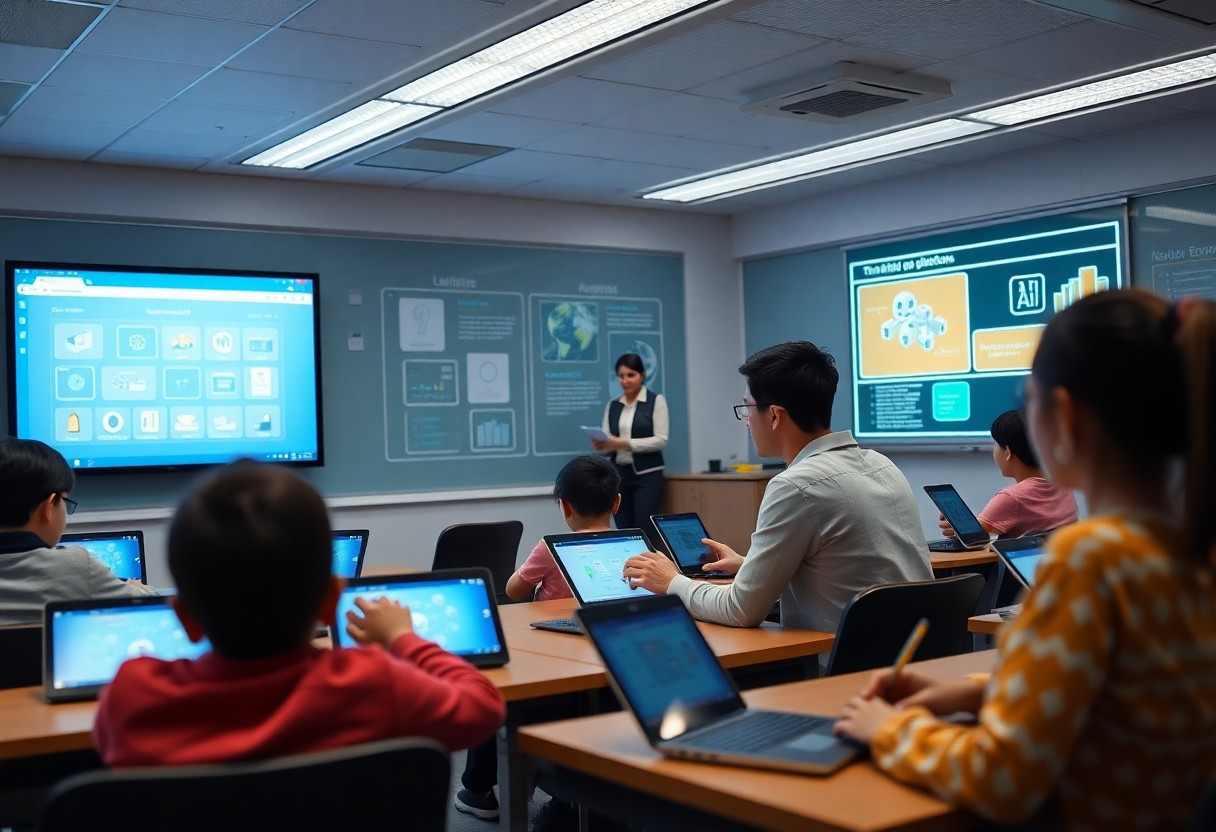Over the past few years, educational technology has transformed significantly, integrating Artificial Intelligence (AI) to create personalized and effective learning experiences. As an educator or administrator, you have the power to harness AI tools and methodologies to innovate your approach to teaching and learning. This listicle outlines ten actionable steps that you can take to effectively enhance your educational technology practices through the strategic implementation of AI. Together, these steps will empower you to optimize learning outcomes and foster an engaging, adaptive environment for your students.
Key Takeaways:
- Personalized Learning: Implement AI to tailor educational experiences to individual student needs, enhancing engagement and improving outcomes.
- Data-Driven Insights: Leverage AI to analyze student performance data, allowing educators to make informed decisions and improve teaching strategies.
- Resource Optimization: Use AI tools to streamline administrative tasks, freeing up educators to focus more on teaching and student interaction.
- Adaptive Assessments: Integrate AI into assessments to dynamically adjust difficulty based on student performance, ensuring a more accurate measurement of understanding.
- Interactive Learning Environments: Create immersive educational experiences using AI technologies, such as virtual reality and gamification, to enhance student motivation and retention.

Assess Current Technology Use
Assessing your current technology use is an crucial first step in enhancing educational technology innovation through artificial intelligence. It involves a thorough evaluation of how existing technologies are being utilized within your learning environment. Understanding the landscape of your current tools and methods allows you to pinpoint areas that may require improvement, leading you toward more effective integration of AI capabilities.
Identify Strengths and Weaknesses
Strengths within your current technology framework may include effective communication tools that facilitate collaboration among students and educators or user-friendly platforms that engage learners. Identifying these strengths helps you to leverage them further and enhance your educational strategies. Conversely, weaknesses might reveal areas where technology usage falls short, such as outdated systems or limited access to resources. By clearly documenting these aspects, you will have a comprehensive view that guides your next steps.
Conducting this analysis will enable you to set benchmarks for future improvements and innovation. Moreover, recognizing strengths empowers you to amplify those elements, while understanding weaknesses gives you the opportunity to address and mitigate challenges that may hinder the adoption of new AI technologies.
Gather Stakeholder Feedback
Now is the time to gather stakeholder feedback from various members of your educational community, including students, faculty, and administrators. Engaging these individuals allows you to uncover valuable insights about their experiences and perceptions of current technologies. Input from diverse perspectives helps you understand both the technical and emotional impact of the tools in place, fostering a more comprehensive view of how technology supports, or potentially impedes, the learning process.
Gather feedback through surveys, interviews, or focus groups to acquire qualitative and quantitative data. This information will not only help you assess the effectiveness of existing technologies but also inform your strategy moving forward. By involving stakeholders in the evaluation process, you create a sense of ownership and collaboration that ultimately strengthens the implementation of innovative AI solutions in your educational environment.
Invest in Teacher Training
If you want to enhance educational technology innovation through artificial intelligence in learning, investing in teacher training should be a top priority. Teachers are the frontline facilitators of technology integration, and their proficiency directly impacts how effectively AI tools are utilized in the classroom. Providing adequate training ensures that educators not only understand the technology but also feel confident in integrating it into their teaching practices.
Provide Comprehensive Professional Development
Training opportunities should be designed to be comprehensive, offering educators deep insights into the AI tools available and how they align with curriculum objectives. Workshops, online courses, and hands-on sessions can empower teachers to explore the full potential of educational technology. Moreover, ongoing professional development ensures that teachers stay updated with the latest advancements in technology and AI, allowing them to continually refine their approach to teaching.
Foster a Culture of Innovation
One effective way to enhance your educational environment is to foster a culture of innovation among your teaching staff. This encompasses encouraging educators to explore new ideas and take calculated risks with technology integration. By establishing an environment where innovation is valued, you motivate your teachers to experiment with AI tools, allowing them to discover what works best for their students.
Teacher collaboration is key in this culture of innovation. When you promote teamwork and idea sharing, teachers can learn from one another’s experiences and collectively enhance their skills. By organizing regular brainstorming sessions, innovation workshops, and peer mentoring, you can create a lively atmosphere that celebrates creativity and proactive problem-solving. Ultimately, fostering such a culture empowers your teachers and enhances the overall impact of educational technology in your learning environment.
Collaborate with AI Experts
Not all educational institutions have in-house expertise when it comes to artificial intelligence (AI) and its applications within learning environments. To bridge this gap, you should seek collaboration with professionals who specialize in AI technology. By partnering with experts in the field, you gain access to valuable insights, advanced tools, and cutting-edge methodologies that can the landscape of your educational technology offerings.
Partner with Research Institutions
With a partnership with research institutions, you tap into a wealth of knowledge and resources that can significantly enhance your AI initiatives. These organizations are often at the forefront of innovation, conducting studies and experiments that explore the potential of AI in education. Collaborating with them not only provides you with advanced research but also opens doors for joint projects, funding opportunities, and access to state-of-the-art facilities.
With this relationship, you can also benefit from their networks of experts and resources that can provide mentorship and guidance. Engaging in joint research initiatives can also empower your team to stay abreast of the latest trends and findings in AI, thereby enhancing your educational tools and strategies effectively. This synergy can lead to the development of tailored solutions that resonate well with your learners’ needs.
Engage in Knowledge Sharing
With a commitment to knowledge sharing among professionals in the education and AI sectors, you can foster a collaborative environment where innovation thrives. Hosting webinars, workshops, and forums where educators can exchange experiences and best practices can significantly enhance your understanding and implementation of AI. Such platforms enable you to learn from others’ successes and challenges, ultimately leading to refined strategies for AI integration.
Collaborate with AI experts who are keen to share insights and research findings, as this can pave the way for a shared repository of knowledge that benefits all participants. By engaging actively in these exchanges, you not only expand your own expertise but also contribute to a collective vision of leveraging AI for a more effective educational landscape. As your network grows, so does your potential for innovative transformations in learning processes.
Integrate Adaptive Learning Systems
Keep in mind that integrating adaptive learning systems into your educational framework can transform the way students experience learning. These systems leverage artificial intelligence to tailor educational content and delivery methods to meet the unique needs of each learner. This personalization not only enhances engagement but also fosters a more effective learning environment where students can progress at their own pace. By implementing adaptive learning technologies, you can create a responsive educational atmosphere that evolves alongside your students’ learning journeys.
Customize Learning Experiences
Some of the most significant benefits of adaptive learning systems come from their ability to customize learning experiences. By analyzing students’ interactions with various materials and assessments, these systems can modify the content delivered, ensuring it aligns with individual strengths and areas that need improvement. This tailored approach means that students can focus on aspects they find challenging while reinforcing their knowledge in areas where they excel. As a result, you empower your learners to take ownership of their educational paths.
Monitor Student Progress Regularly
The integration of adaptive learning systems also enables you to monitor student progress regularly. These platforms collect and analyze data on how each student is performing, providing valuable insights into learning trends and areas for intervention. With this information at your fingertips, you can make informed decisions about resource allocation and instructional strategies that resonate with your students’ needs. Regular monitoring allows for timely support and adjustments, creating a responsive learning ecosystem that fosters success.
For instance, if a student struggles with certain math concepts, the system can quickly identify these areas and suggest additional practice materials or alter the learning path to reinforce understanding. This proactive approach not only aids in remediation but also helps prevent students from falling behind. By keeping a close eye on progress and adapting learning experiences accordingly, you enhance the educational landscape and drive better outcomes for your students.
Implement Data-Driven Decision Making
Many educational institutions are now realizing the immense potential of data-driven decision making in enhancing learning experiences. By systematically collecting and analyzing data, you can gain insights into student performance, engagement levels, and overall learning outcomes. This information not only allows for a more targeted approach to teaching but also equips you with the tools necessary to provide personalized learning experiences that cater to individual student needs. As you incorporate artificial intelligence (AI) into your learning environments, you can leverage the power of data analytics to make informed decisions that drive innovation and improvement in educational technology.
Analyze Learning Outcomes
For effective data-driven decision making, the first step is to analyze the learning outcomes of your students. By examining data sets that reflect student progress and achievement, you can identify patterns that indicate which teaching methods are working and which ones may require modification. This analysis enables you to set specific goals and benchmarks to measure success, allowing you to create a more dynamic and responsive learning environment. Utilizing AI tools can further enhance this process, as they can process large volumes of data quickly and efficiently, identifying key trends that may not be immediately visible.
Adjust Strategies Accordingly
The next step involves adjusting your strategies based on the insights derived from your analysis of learning outcomes. Once you have a clear understanding of what works and what doesn’t, you can modify your teaching methods, materials, and technology use to better serve your students. This might involve integrating new digital tools or resources that enhance engagement, adapting your curriculum to include more relevant content, or providing additional support for students who may be struggling. By staying proactive and open to change, you enable an especially adaptable educational environment.
Strategies should be continuously revisited and refined as you collect more data over time. The evolving nature of educational technology means you must stay in tune with your learners’ needs and the success of the implemented tools. Following this iterative process not only helps you maintain a high level of educational quality but also ensures that your approach remains relevant and effective in inspiring and educating your students.
Encourage Student Engagement
Once again, fostering active student engagement is crucial to successfully integrate educational technology with artificial intelligence in learning. Engaging students not only enhances their motivation but also improves their learning outcomes. When students are actively involved in their educational journey, they are more likely to retain information and develop critical thinking skills. As you strive to enhance engagement in your learning environment, consider approaches that inspire participation and stimulate interest among your students.
Utilize Interactive Tools
Even with the wealth of online resources available, interactive tools can significantly elevate the learning experience. Platforms that allow for real-time discussions, live polling, or gamified learning activities create a dynamic atmosphere where students feel valued and heard. By integrating technology that encourages students to participate actively, you can transform passive learning into a collaborative and interactive adventure. Consider tools such as discussion forums, interactive quizzes, and simulations that invite students to dive deeper into the content while sharing their insights with peers.
Promote Personalized Learning Paths
Encourage your students to take ownership of their learning through personalized learning paths. By leveraging AI-driven technology, you can tailor educational experiences to meet individual needs, preferences, and learning speeds. This individualized approach allows students to explore topics that resonate with them while offering support where they need it most. As you facilitate these learning paths, be sure to provide guidance and resources that empower students to make informed choices about their educational journeys.
Engagement becomes a driving force when you provide opportunities for students to shape their learning experiences. Personalized learning paths not only cater to diverse learning styles but also instill a sense of responsibility among students. When they see their choices play a role in their success, it fosters motivation and a greater investment in the material. By effectively incorporating personalized learning strategies, you can create a more engaging and enriching educational environment that meets the unique needs of each learner.
Foster Creativity and Critical Thinking
Unlike traditional educational methods that often lack engagement, fostering creativity and critical thinking in your teaching practices can transform the learning experience. By integrating strategies that encourage students to explore, experiment, and engage with information creatively, you help develop their cognitive skills alongside their academic knowledge. This not only prepares them for real-world challenges but also cultivates a mindset of innovation and adaptability.
Design Project-Based Learning
Clearly, project-based learning (PBL) offers an excellent platform for students to express their creativity while honing their critical thinking skills. By allowing students to work on projects that are both intriguing and multi-faceted, you create opportunities for them to ask questions, conduct research, and come up with innovative solutions. This type of learning fosters a deeper understanding of the subject matter as students immerse themselves in real-world problems and actively seek ways to address them.
Moreover, PBL allows for collaborative efforts among students, promoting teamwork and communication skills important for today’s workforce. As you design these projects, consider incorporating elements that stimulate inquisitiveness and require students to think critically about their approaches. You can guide them in setting specific objectives and criteria for success, encouraging them to iterate and improve their work based on feedback, which can further enhance their learning experience.
Incorporate Real-World Challenges
On the other hand, incorporating real-world challenges into your curriculum invigorates the learning environment and encourages students to apply their knowledge in practical scenarios. This approach not only makes learning more relevant but also heightens students’ investment in their education as they see the direct impact of their work. It fosters a sense of responsibility and encourages them to think critically about solutions that are not only innovative but also viable in the real-world context.
Plus, leveraging current events, societal issues, or local community challenges allows students to engage with subjects that matter. This engagement makes education feel less abstract and more applicable to situations they may face outside a classroom setting. By guiding learners through the process of identifying problems, brainstorming solutions, and implementing their ideas, you instill a sense of empowerment and ownership over their learning journey. As students navigate these challenges, they learn to draw connections between theories and practices, reinforcing both creativity and critical thinking.
Evaluate and Refine Initiatives
Despite the significant investment in educational technology and artificial intelligence, the path towards effective implementation is not always smooth. Evaluating and refining your initiatives are necessary to ensure that you achieve your objectives and maximize positive outcomes. This involves not only measuring success but also being open to making changes based on insights gained from your efforts.
Collect Continuous Feedback
An ongoing dialogue with stakeholders—including educators, students, and parents—can provide invaluable insights into how well your educational technology initiatives are functioning. Regularly soliciting feedback through surveys, focus groups, or direct discussions allows you to assess the user experience and determine areas needing improvement. The more comprehensive your feedback collection, the better equipped you will be to understand the challenges and successes related to your AI integration.
It’s important to create an environment where all stakeholders feel comfortable sharing their thoughts and experiences. This is where transparency comes into play; by openly communicating how feedback will be used to inform decisions, you foster a culture of trust and collaboration, paving the way for relatively swift adjustments to your strategies based on real-world experiences.
Make Iterative Improvements
You should view the evaluation of your initiatives as an iterative process that allows for continuous refinement. As feedback comes in, prioritize changes based on impact and feasibility. Engage your team in brainstorming sessions to discuss potential improvements and develop actionable plans. These sessions can also serve to identify quick wins that can boost morale and build momentum for larger changes down the line.
With a focus on making iterative improvements, you create an adaptive learning environment that responds to the needs of your users. Rather than viewing your initial implementation as final, consider it the first step in a cycle of continual enhancement. This approach not only improves the technology itself but also shifts the mindset of educators and students, empowering them to embrace change as a constant rather than a disruption.
Scale Successful Practices
Your journey to enhance educational technology through artificial intelligence doesn’t stop with implementation; it requires scaling successful practices that resonate, adapt, and thrive across diverse educational settings. By doing so, you can maximize the benefits that AI brings to learning, ensuring that innovations reach as many students and educators as possible. Scaling demands both strategy and a willingness to share knowledge that can empower others to mimic or adapt your successes.
Share Best Practices Widely
Widely disseminating best practices allows you to create a comprehensive resource that educators can draw from. By documenting your processes, outcomes, efficiency gains, and lessons learned, you present a roadmap that others can follow. Consider blogging, webinars, workshops, or even collaborating with educational institutions to distribute this valuable information. Your insights will foster a community of learning where others can implement tested strategies without duplicating efforts or facing the same challenges you overcame.
Inspire Broader Adoption
You’ll find that inspiring broader adoption of successful practices requires more than just sharing resources; it also involves actively engaging with educators and decision-makers. Host engaging discussions, attend conferences, or participate in online forums dedicated to educational technology. These platforms allow you to champion the effective use of AI in the classroom, enticing others to embrace new methodologies that have shown promise.
Share your enthusiasm and success stories to create a ripple effect in educational communities. By highlighting the tangible benefits of AI tools, you can motivate peers to explore innovations that can enhance their own teaching practices. This shared vision can lead to a collective goal of advancing educational technology, transforming the standard learning environment into a more engaging and effective space for all learners.
Final Words
Considering all points, you will find that implementing the ten steps to enhance educational technology innovation through artificial intelligence can transform your approach to learning and teaching. By integrating AI tools and resources thoughtfully, you can create a more personalized and engaging educational experience for your students. Evaluate your current technology landscape, be open to experimentation, and collaborate with other educators to harness the full potential of AI in your curriculum. This proactive approach will empower you to stay at the forefront of educational innovation.
You also have the opportunity to advocate for necessary training and resources that support both teachers and students in navigating these advancements. By developing a clear strategy and embracing ongoing professional development, you can ensure that AI serves as a powerful ally in the learning process. Let your journey into educational technology be characterized by curiosity and a commitment to improvement, as you empower the next generation of learners with cutting-edge tools and insights.
FAQ
Q: What are the key benefits of incorporating artificial intelligence in educational technology?
A: Incorporating artificial intelligence in educational technology can lead to personalized learning experiences, adaptive assessments, and enhanced engagement. AI can analyze student data to tailor educational resources to individual learning styles, enabling educators to provide support that is specific to each student’s needs. Additionally, AI tools can automate administrative tasks, freeing up time for teachers to focus on instruction and mentorship.
Q: How can institutions begin the process of integrating AI into their educational frameworks?
A: Institutions can start by conducting thorough research to understand the available AI tools and their potential applications in the classroom. Engaging stakeholders, including educators, students, and parents, in discussions about their needs and expectations can guide the selection of appropriate AI solutions. Establishing pilot programs to test various AI technologies on a smaller scale can also provide valuable insights before full implementation.
Q: What role do educators play in the successful adoption of AI in learning environments?
A: Educators play a vital role in the adoption of AI technologies by providing feedback on their efficacy and user-friendliness. They can also advocate for the integration of AI tools that align with pedagogical goals. Professional development opportunities that focus on understanding AI and its applications can empower educators to effectively utilize these technologies to enhance their teaching methodologies and improve student outcomes.
Q: What challenges might institutions face while implementing AI in educational technology?
A: Institutions may encounter several challenges while implementing AI, including resistance to change from faculty or administration, concerns about data privacy and security, and the need for substantial training on new technologies. Additionally, ensuring equitable access to AI tools for all students can be a concern, especially in under-resourced environments. Institutions will need to develop strategies to address these challenges collaboratively.
Q: How can educational stakeholders ensure that AI technologies are used ethically in learning environments?
A: To ensure ethical use of AI in education, stakeholders should establish clear guidelines and policies that govern data usage, privacy, and bias mitigation. Continuous monitoring and evaluation of AI systems for fairness and transparency are important to address any unintended consequences. Engaging with diverse communities during the development and deployment of AI technologies can help to identify ethical considerations and promote inclusiveness in the learning process.




